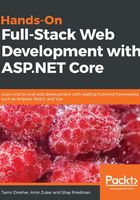
Full-stack development
Full-stack development refers to a client-server architecture model, or, as it's more commonly known, the frontend and backend. These are different in almost every single aspect. Backend development refers to writing code for the server side—handling data, providing APIs, managing security, deployment, and more. Frontend development refers to writing code for the client side—in our case, web clients running in users' browsers, working on the user interface, presentation logic, browser compatibility, performance, responsiveness, and more.
The backend and frontend parts do not usually share code; it might be written in entirely different programming languages, and run on different types of machines and in geographical locations. They communicate through the network via the HTTP protocol with the help of standards, ideas, practices, and architectural styles such as REST and JSON. The most notable difference between the backend and the frontend is the intended end user that interacts with each one of them—the backend interface serves computer systems, while the frontend interface serves human beings, as shown in the following diagram:

Being a full-stack developer means that you are an all-around developer who understands the different concepts and responsibilities of each part and, moreover, is able to take an idea and implement it from the very first line of code to a finished and deployed product.
In order to begin diving into full-stack development, let's get familiar with the concepts, responsibilities, and technologies for each part of the stack.